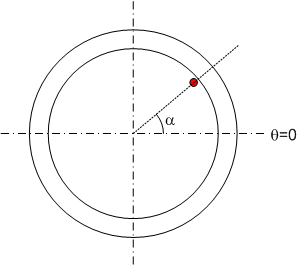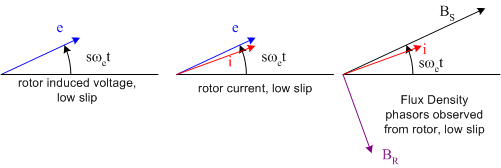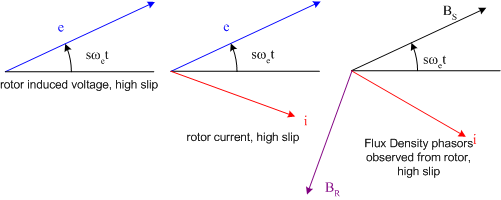Principles of Operation
The basic idea behind the operation of an induction machine is quite simple. Detailed mathematical understanding of the interaction of magnetic fields and resultant torque is more complex. In many cases, understanding the qualitative ideas and then applying a circuit model is sufficient. The qualitative description is provided here, together with a more mathematical description for those who prefer that type of approach. The mathematical description also includes some important definitions that are required in order to develop a circuit mode.
Qualitative Description
- The three-phase stator winding is connected to a three-phase supply
- Currents flow in the stator winding, producing a rotating mmf and flux density
- The stator flux density rotates at synchronous speed:
\[ n_s= \frac{120 f_e}{p} \]
- The magnetic field passes conductors on the rotor and induces a voltage in those conductors
- Since the conductors are short circuited, current flows in the rotor conductors
- The rotor currents produce a second rotor magnetic field, which acts to oppose the stator magnetic field and also rotates at synchronous speed
- With two magnetic fields rotating at constant speed, a torque is induced:
\[ \tau = k \vec{B}_R \times \vec{B}_S \]
- The rotor flux density will lag the stator flux density (flux density lags current by 90° electrically), therefore the torque will be in the same direction as the rotation of the magnetic fields
- The torque accelerates the rotor until synchronous speed is reached, at which time there is no relative motion between the conductors and the stator flux density. Since the relative velocity is zero, the induced voltage, rotor currents and flux density fall to zero and torque is also zero
Mathematical Principles
Definitions
- supply frequency: \(f_e\) in Hz or \(\omega_e\) in rad s-1
- synchronous speed (radians per second): \(\omega_s\)
- synchronous speed (revolutions per minute): \(n_s\)
- rotor mechanical speed (radians per second): \(\omega_m\)
- rotor mechanical speed (revolutions per minute): \(n_m\)
- rotor electrical speed (electrical radians per second): \(\omega_r\)
- slip: difference between synchronous and mechanical speeds divided by synchronous speed:
\[ \begin{aligned} s & = \frac{\omega_s-\omega_m}{\omega_s} \\ s & = \frac{n_s-n_m}{n_s} \\ s & = \frac{\omega_e-\omega_e}{\omega_e} \end{aligned} \]
- slip speed:
- in rpm: \(sn_s=n_s-n_m\)
- in rad s-1: \(s\omega_s = \omega_s-\omega_m\)
- slip frequency:
- in Hz: \(f_{sl}=s f_e\)
- in rad s-1: \(\omega_{sl}= s \omega_e = \omega_e-\omega_r\)
Induced Rotor Voltage
As illustrated in the fundamental theory on rotating fields, passing balanced three-phase currents through a balanced three-phase winding can produce a rotating mmf wave. The mmf rotates at synchronous speed, set by supply frequency and the number of poles in the machine. In an induction machine the air gap of the machine is designed to be constant, therefore the rotating mmf will produce a rotating flux density. The stator flux density can be defined in terms of either mechanical or electrical quantities:
In the above equation \(\phi_m, \phi_e\) are arbitrary phase angles in mechanical and electrical angles respectively. We will set these to zero. \(\theta\) is the location at which the flux density waveform is observed. (At a given location, the flux density varies sinusoidally with time. At a given time, the flux density varies sinusoidally with location.) Now, to understand how an induction machine works, we need to consider the flux density seen by a conductor on the rotor.
In the image in Fig. 1 , there is a rotor conductor at position \(\theta_m=\alpha\). If the rotor is stationary then the rotor will observe the the stator flux density as
However, if the rotor is rotating at mechanical speed \(\omega_m\) the location of the conductor becomes
where \(\alpha\) is the position of the conductor relative to the rotor.

The flux density seen by the conductor is now given by
Now, the voltage induced in a conductor of length l moving perpendicular to a magnetic field is given by
and the relative velocity of the conductor through the magnetic field is given by
Therefore (choosing the definition of the direction of the conductor to elimate the -ve sign) the voltage induced in the conductor is given by
Two important results can be seen in the above equation:
- The induced voltage is proportional to slip
- The frequency of the induced voltage is proportional to slip
Rotor Currents and Field
Current Magnitude and Phase
Without knowing the full details of the rotor circuit, we can makes some assumptions about the circuit to enable us to understand the behaviour of the induction machine. We will assume that the rotor conductor is part of a circuit with constant resistance \(R_R\) and inductance \(L_R\). (We will see later that resistance can actually vary with slip, but will assume that it is constant for now). Now, if slip is low (close to zero) then the reactance associated with the inductance will be negligible since the frequency will be very low. In this case, though induced voltage is small, the induced currents may be significant since the conductors are short circuited and \(R_R\)is low. Currents will be approximately in phase with the induced voltage. If slip is high (close to 1) then the rotor reactance will be significant. Due to the increase in induced voltage, rotor currents will be high, but will lag the induced voltage significantly due to the inductance of the rotor circuit.
Rotor Flux Density
We know that the flux density produced by a set of ac currents rotates at a speed given by
In the case of the rotor currents, the above equation gives the speed of rotation relative to the conductors. The actual speed of rotation of the flux density will be given by
i.e. the rotor magnetic field rotates at synchronous speed. We can get an understanding of the relative position of the rotor and stator fields by drawing phasor diagrams. The phasor diagram of the stator flux density phasor can be drawn from either a stator reference frame, where it rotates at electrical speed \(\omega_e\), or from a rotor reference frame, where it rotates at electrical speed \(\omega_{sl}\)

First consider the case where slip is low. Induced current lags induced voltage slightly, the rotor flux density is almost 90° electrically behind the stator flux density.

From
at low slips, the angle between flux density phasors is close to 90° and the torque will be approximately proportional to induced voltage and therefore proportional to slip.
Now consider the case where slip is close to 1.0, mechanical speed is close to zero. In this case, rotor current lags induced voltage and the angle between rotor and stator flux densities is much greater.

From the torque equation, even though the magnitude of the induced currents is higher and the rotor flux density phasor has a larger magnitude, torque will not necessarily be higher than it is a low slips.
Summary
- Induction machines produce torque at all speeds except synchronous speed
- Induction machines can operate with only one electrical source, they do not require a source to be connected to the rotor.
- Rotor currents and torque are nonlinear functions of slip, a measure of the relative speed between the stator magnetic field and the rotor mechanical speeds